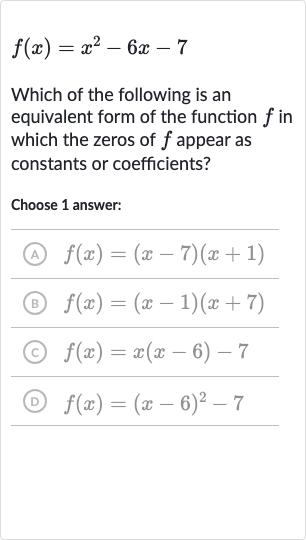Full solution
Q. Which of the following is an equivalent form of the function in which the zeros of appear as constants or coefficients?Choose answer:(A) (B) (C) (D)
- Find Zeros: To find an equivalent form of the function that shows the zeros, we need to factor the quadratic equation .We look for two numbers that multiply to and add up to .The numbers and satisfy these conditions because and .
- Factor Quadratic Equation: We use these numbers to factor the quadratic equation:f(x) = f(x) = This is the factored form of the quadratic equation, which reveals the zeros of the function.
- Compare with Answer Choices: We compare the factored form with the given answer choices to find the matching one.(A) matches the factored form we found in Step .
- Compare with Answer Choices: We compare the factored form with the given answer choices to find the matching one.(A) matches the factored form we found in Step .We check the other answer choices to confirm that they do not match the factored form we found:(B) does not match because it would expand to .(C) does not match because it would expand to , but does not show the zeros as constants or coefficients.(D) does not match because it would expand to .
More problems from Compare linear and exponential growth
QuestionGet tutor help
QuestionGet tutor help
QuestionGet tutor help
QuestionGet tutor help
QuestionGet tutor help
QuestionGet tutor help
QuestionGet tutor help

